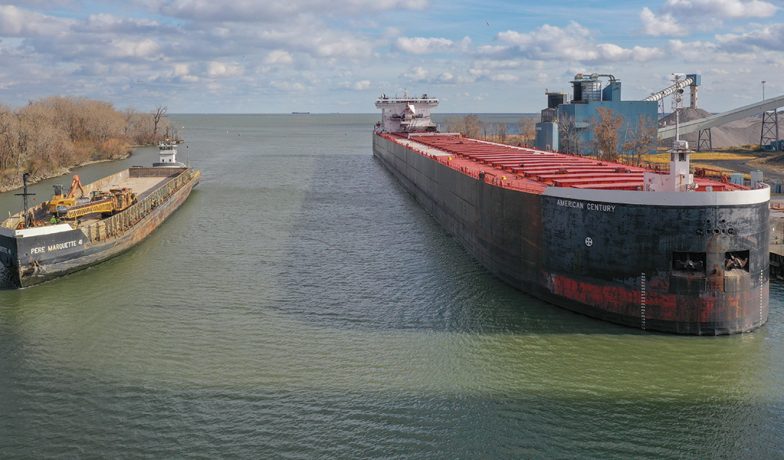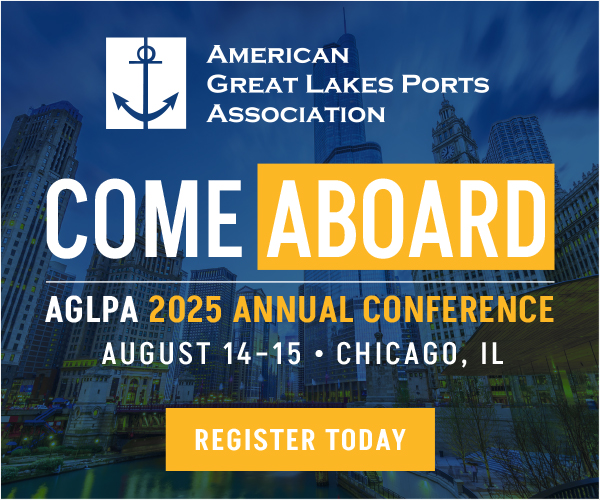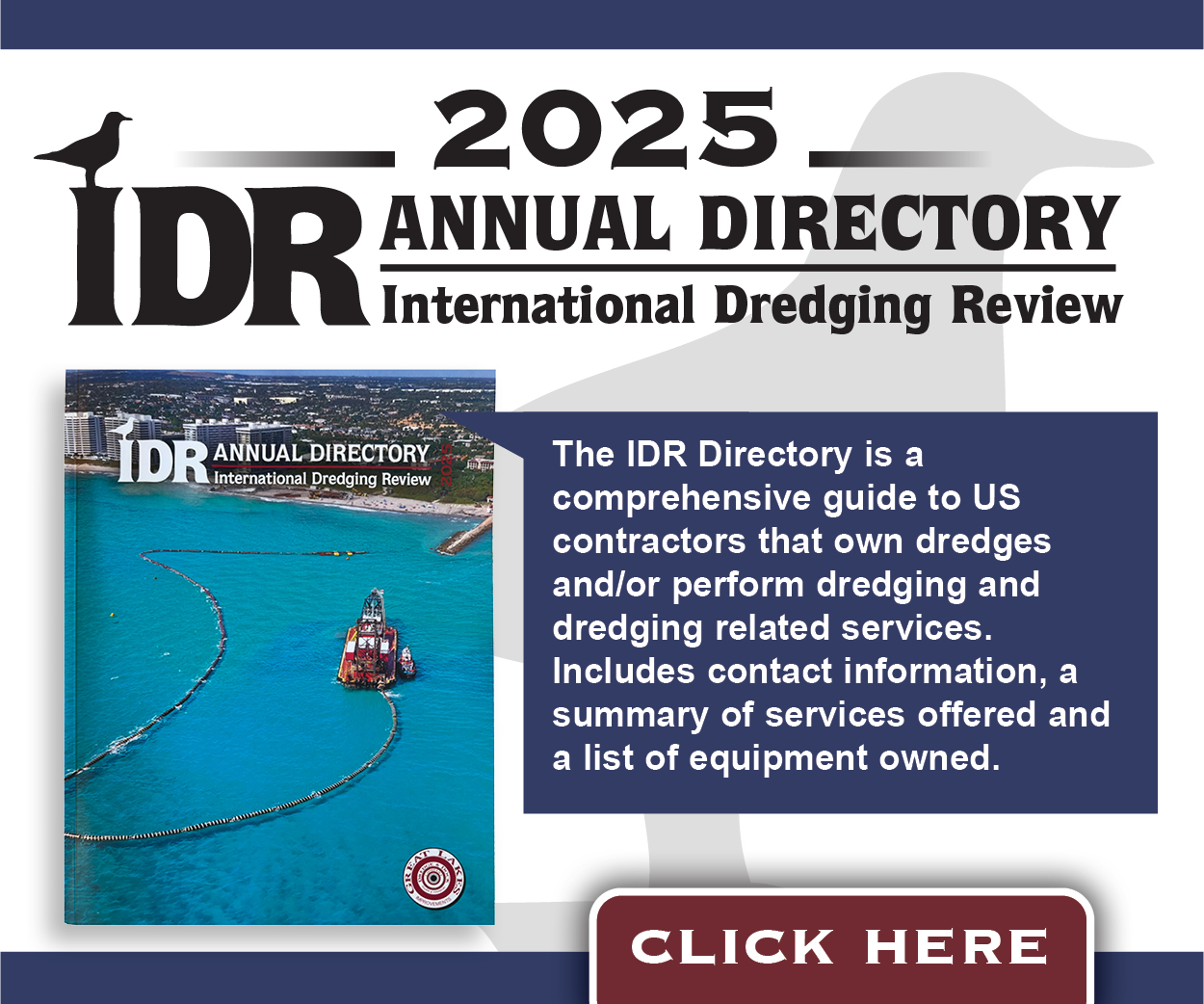Investing in the Future
Bi-National Survey Finds Great Lakes is Essential to North American Economy
The commitment to solidify the Great Lakes-St. Lawrence Seaway system as an integral part of the North American economy and the maritime shipping industry remains stronger than ever, according to a recent study sponsored by a binational coalition of stakeholders.
Conservative results from the Infrastructure Investment Survey of the Great Lakes and St. Lawrence Seaway System found that $8.4 billion USD (C$10.9 billion) has been committed by the public and private sector in infrastructure improvements of the Great Lakes-St. Lawrence Seaway system from 2018-2027.
More than 700 private companies and government agencies in the United States and Canada took part in the survey, prepared by Martin Associates of Lancaster, Pennsylvania. The survey focused on vessel operators, ports, terminals, government agencies and other entities to determine the level of investments made in the navigation system from 2018 to 2027.
Other results from the investment report include:
- $5.7 billion was invested in the Great Lakes-St. Lawrence Seaway system over the last five years.
- $636 million was invested by vessel operators for new ships and upgrades over the last five years. Another $328 million will be invested by 2027.
- $2.1 billion was invested by Great Lakes ports and terminals for facility improvements and equipment between 2018-2022. An additional $1.1 billion will be invested by 2027.
- $3 billion was invested in locks, navigation channels and breakwaters. Another $1.2 billion will be invested by 2027.
The survey is part of a larger project which was released last July titled Economic Impacts of Maritime Shipping in the Great Lake-St. Lawrence Seaway Region. That study reported that 2022 maritime commerce on the system supported $36 billion (USD) in economic activity; more than 240,000 U.S. and Canadian jobs; the movement of 135.7 million metric tons of raw materials and finished goods; and $6.3 billion (USD) in state and federal taxes.
The report was sponsored by the American Great Lakes Ports Association, the Lake Carriers’ Association, the Shipping Federation of Canada, the Chamber of Marine Commerce, the St. Lawrence Seaway Management Corporation and the Great Lakes St. Lawrence Seaway Development Corporation.
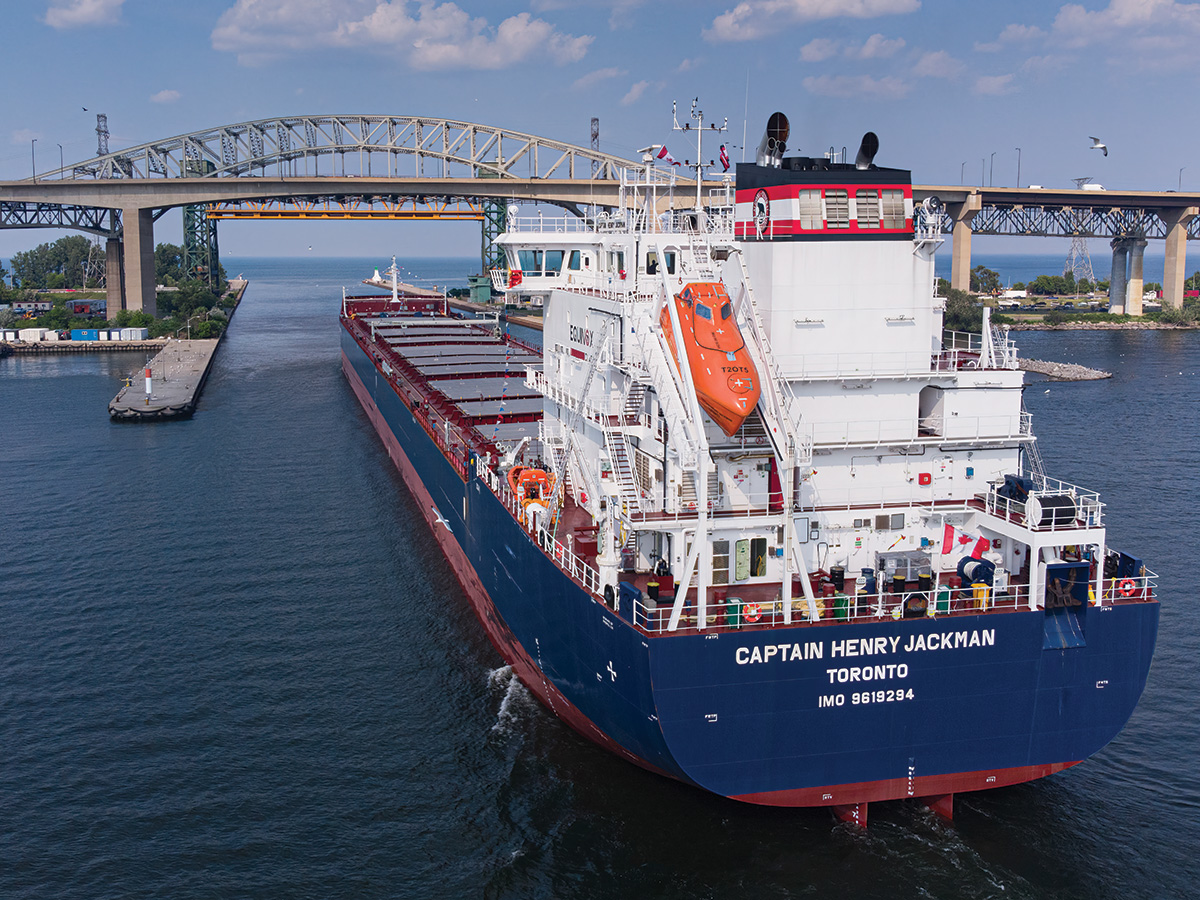
Great Lakes/Seaway Review interviewed Bruce Burrows, president and CEO of the Chamber of Marine Commerce, about the results of the study, how it will impact future development on the system, and his hopes for the Great Lakes shipping industry.
GL/SR: Why was it important to this binational coalition to create this study?
Bruce Burrows: Our motivation to pursue this study was to quantify ongoing investments in the navigation system across North America. Our goal was to help support long term planning and the achievement of economic development goals, while also building confidence in the system’s future viability.
However, we achieved much more than this upon review of the final numbers. The investment study conservatively estimates that C$10.9 billion ($8.4 billion USD) will be spent to enhance marine shipping on the Great Lakes and St. Lawrence Seaway between 2018 and 2027. This demonstrates the strength of commitment on the part of the marine shipping industry, and on the part of governments at all levels, to fully realize the immense potential marine shipping holds to support economic growth, enhance supply chains, help businesses pursue new markets and achieve carbon reduction goals.
It bears noting that the total investment number reflects new investment only – money spent by private sector and government to expand and enhance current infrastructure or support research and development to make the Great Lakes and St. Lawrence Seaway an even stronger conduit for North American trade. Money spent on annual maintenance is not included in the study. It also bears noting that no study could fully capture all investment. This comprehensive study surveyed over 800 private and public sector organizations in Canada and the United States, and achieved an impressive 70 percent response rate, but as not all responded, we note that the C$10.9 billion ($8.4 billion USD) is a conservative estimate and acknowledge that total investment is even larger.
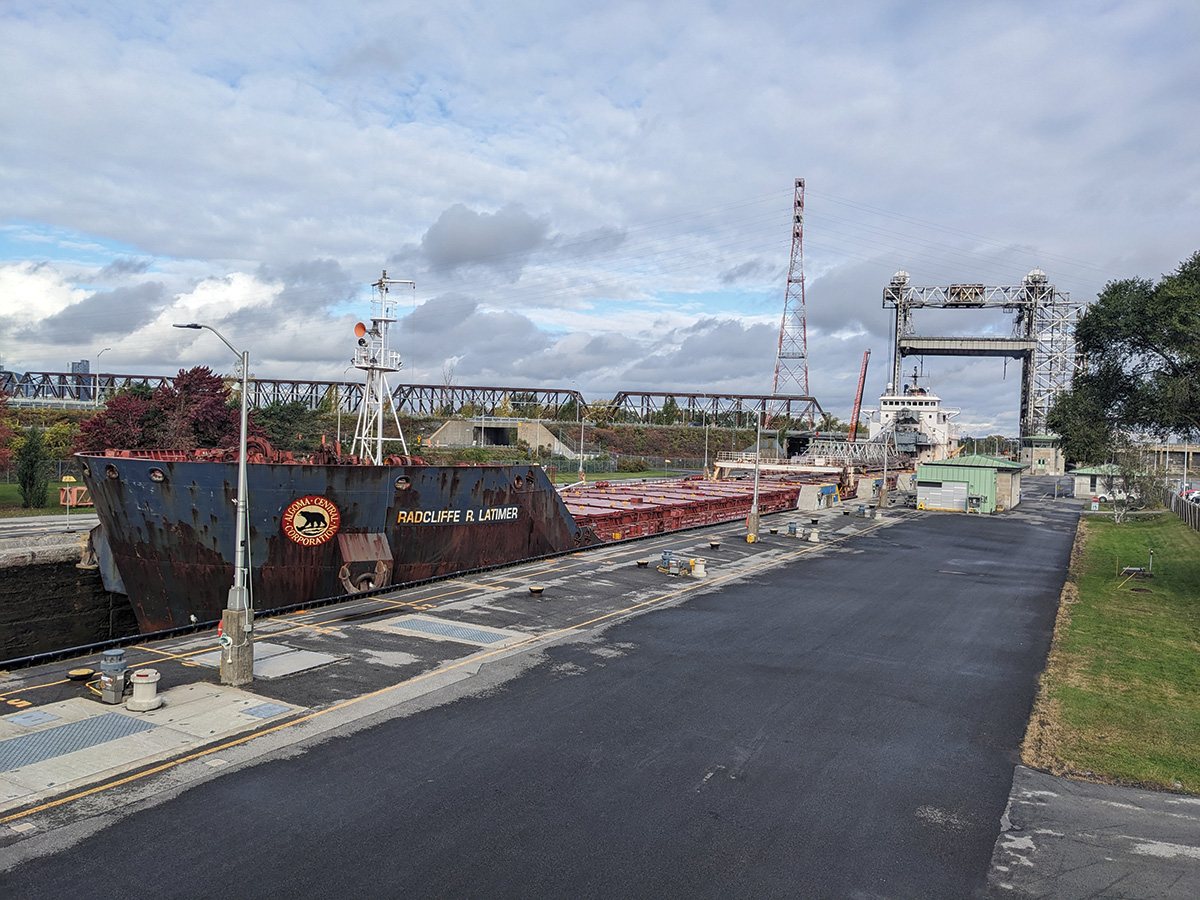
GL/SR: How important will the results be to the betterment of the Great Lakes-St. Lawrence Seaway system?
Burrows: We live in a time of rapid transition and the world is being rebuilt to achieve greater sustainability and efficiency in the face of climate change, global trade developments and other factors. Governments are responding with unprecedented investment in infrastructure and interest in transportation initiatives. We see that in the U.S. Government’s Bipartisan Infrastructure Law and Inflation Reduction Act, Canadian Government’s Green Shipping Corridor Program and new Transportation Supply Chain Office, and the Ontario Government’s first ever Marine Transportation Strategy.
Our industry’s efforts to create reliable, credible and independent information that governments can use to support their decision making has facilitated continued investment. This is why we had Martin Associates produce an economic study, released last July, to highlight the economic impact, job creation, wage generation and taxes paid because of the marine shipping industry, and it is why we had this investment study generated as a secondary project.
We have seen both the U.S. Secretary of Transportation and the Minister of Transport Canada embrace the Martin economic study as a valuable information resource, and the Government of Ontario used the numbers to help inform the details of its marine strategy. Now that we have the investment survey, governments not only have data regarding where investment is being directed but can also see that the private sector is making billions of investments on its own to remain a leader as the most efficient and green mode of moving what matters.
GL/SR: Based on the findings, was the coalition surprised by the amount of funding being invested in the system?
Burrows: No, I don’t think so. Our industry has been ahead of the curve for many years with respect to developments that would give us an edge when it came to achieving a lower carbon footprint and making better use of information management technology and artificial intelligence.
The Chamber of Marine Commerce’s (CMC’s) membership has also been very aggressive in our pursuit of new ways to power shipper competitiveness. You see all of that in the trial tests of alternative fuels and experimentation with electrification of ports. You see it port side, with offerings of new short sea shipping and related services. You see it in the expansions happening at ports that enable new shipping routes and storage options. All these developments required significant vision and investment, and all were undertaken with the knowledge that it would position our industry for more activity in the future as businesses and governments seek cleaner, greener and more reliable ways to move their goods.
It was encouraging to see the level of investment by federal, provincial and state governments in our industry, though it is important for the Chamber of Marine Commerce that we see a similar level of investment ambition on both sides of the border. While the U.S. government has aggressively pursued the economic growth, job creation, and net zero benefits that are achieved through investment in infrastructure, the Canadian government has, to date, only taken “early steps.” Restoring the funding available through important programs like the National Trade Corridor Fund would help ensure marine shipping organizations on both sides of the border keep pace with each other and maintain harmony through the system.
GL/SR: What more needs to be done to improve the system?
Burrows: Discussions about what needs to happen with the system in the coming years began when our industry and the U.S. and Canadian governments came together in Chicago in early 2023 to discuss the pursuit of a shared vision regarding the creation of a green shipping corridor.
As part of those discussions, we are seeking agreement on what alternative fuels to pursue together, and we are also looking at better ways to share data and utilize artificial intelligence. We can expect these two areas to be a major focus for everyone, and our joint efforts will ultimately give advantages to businesses and consumers across North America.
GL/SR: In your opinion, what were the most important results that came from this study?
Burrows: For me, the study reveals three important facts about the future of the economy, supply chains and net zero initiatives in North America – specifically that:
- Marine shipping is enhancing its competitive strengths – The marine shipping industry is actively building on its reputation as the most efficient, reliable and sustainable way to move cargo.
- Marine shipping is leading sustainable economic growth – There is broad recognition that economic growth and net zero ambitions can be achieved through significant investment in marine shipping, and our industry is ready to lead the global transition to net zero.
- Marine shipping is vital to the global economy – Seaway infrastructure and its users provide a key conduit for commercial activity for North American businesses – a vital conduit that is receiving continuous investment to keep it modern and ahead of the needs of businesses and consumers.
GL/SR: What do you hope the public gains and learns from this study?
Burrows: The reliability of the marine shipping industry on the Great Lakes – St. Lawrence Seaway can sometimes be a double-edged sword: it attracts shippers who want certainty in their logistics planning, but it also results in the public taking for granted what we do and not noticing.
It is my hope that the public sees the extraordinary level of investment going into marine shipping in our shared waterway and realize our industry is committed to being at the forefront of sustainable economic growth. We aren’t resting on our laurels as “the green mode;” instead we aim to set new standards of achievement for the rest of the world to follow.
GL/SR: What should Great Lakes ports, shippers and stakeholders be thinking about or planning for as the system gears up for the start of the 2024 shipping season?
Burrows: We need to continue the work that was started in Chicago. We need to see a shared approach to investment and regulation between the Canadian and U.S. governments, especially when it comes to ballast water regulations, supporting green investment and especially protecting the Seaway from unnecessary disruptions. And we need to keep providing good information to governments and engaging in advocacy that encourages greater use of marine shipping within a multi-modal supply chain.
GL/SR: As the shipping industry continues to adopt new decarbonization initiatives, what more do Great Lakes ports need to do to become carbon neutral?
Burrows: It is more a matter of following through on the priorities and ambitious plans that the ports have already set out for themselves. We are seeing ports pursuing opportunities to get greener by making use of new funding opportunities made available by the U.S. and Canadian governments. The Port of Cleveland recently committed to a Climate Action Plan, with the goal of achieving net-zero greenhouse gas emissions by 2050, showing real leadership in sustainability. And we have broad-based participation in the joint effort that began in Chicago – one that I am excited to see continue in 2024.
GL/SR: The industry is dealing with a lot of issues, many beyond its control. The Great Lakes shipping industry experienced firsthand the far-reaching effects of what a strike can do to the economy. With issues such as the implications of a strike, inflation, and a lack of skilled workers, among others, what steps can industry stakeholders take to deal with these issues and prepare for a successful future?
Burrows: Once again, we see challenges that our industry is working on collectively and collaboratively. With respect to the strike, industry has come together with Seaway officials to discuss that experience and how to better manage a similar situation in the future. Thankfully, the St. Lawrence Seaway Management Corporation had kept its compensation of it staff in pace with inflation in years past, and so the increases given recently to end the strike are not expected to significantly increase costs industry wide. With respect to seeking out skilled labor, we are seeing appeals being made to governments to help attract talent into our well-paying industry, and in Canada, the CMC’s sister organization, the Canadian Marine Careers Foundation, is working closely with industry, educational institutions, and government to ensure our industry has access to the talent it needs in the years ahead.
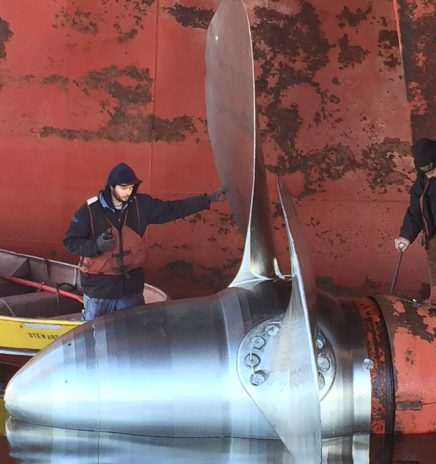
Developing the Workforce of the Future
It’s well known across all maritime sectors that workforce recruitment and development loom as a particularly challenging set of issues over the next decade. Workforce is one of four top... Read More
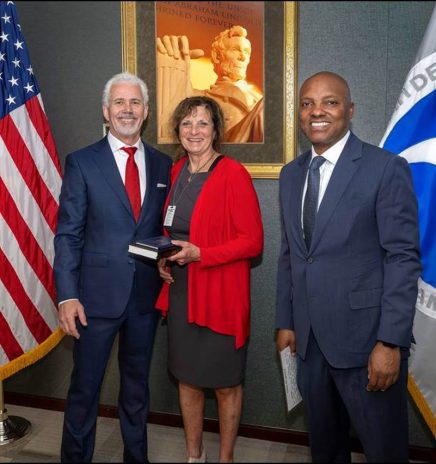
J.M. (Mike) McCoshen Sworn in as GLS Administrator
The United States Department of Transportation has named J.M. (Mike) McCoshen as administrator of the Great Lakes St. Lawrence Seaway Development Corporation (GLS). McCoshen was sworn in on Monday, June... Read More

